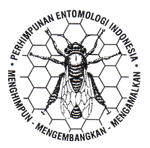Komunitas serangga yang berasosiasi dengan buah Ficus racemosa L.
DOI:
https://doi.org/10.5994/jei.14.2.80Keywords:
Agaonidae, fig trees, Hymenoptera, mutualism, non-mutualisAbstract
Pollination within syconium (figs) of the fig trees (Ficus spp.) depends on female fig wasps that belong to Family Agaonidae (Order Hymenoptera); on the other hand, the female wasps can only lay eggs inside the fig flowers in which the offspring later develop. Several species of non-pollinating wasps are also known to develop within the figs. A research to investigate the fig wasps community (pollinator and non-pollinator) and their impact on the figs has been conducted on fig tree species of Ficus racemosa L. in Aceh Province. Fig fruits of F. racemosa were sampled when they were on receptive stage (B-phase) and when the figs were almost mature (D-phase) on the same trees. The young figs were dissected to observe the pollinating wasps (foundresses), while the mature figs were incubated until the new generation of fig wasps emerged from the figs. The wasps then were identified and counted. Observations on B-phase figs showed that the pollinating wasps of F. racemosa was Ceratosolen fuscicep (Mayr) (Hymenoptera: Agaonidae) which entered the fig through ostiole. The fig wasps community that emerged from D-phase figs consisted of pollinating and non-pollinating fig wasps, Platyneura fusca dan P. agraensis (Hymenoptera: Agaonidaed) were the competitors of pollinating wasps in taking the ovules for their development, while Apocrypta sp. (Hymenoptera: Pteromalidae) was a parasitoid of the pollinator. However, in this research there was no evident that the presence of these non-pollinating wasps significantlyt affect the number of pollinating wasps and seeds of F. racemosa.
Downloads
Downloads
Published
How to Cite
Issue
Section
License
Authors who publish with this journal agree to the following terms:
- Authors retain copyright and grant the journal right of first publication with the work simultaneously licensed under a Creative Commons Attribution 4.0 International License that allows others to share the work with an acknowledgement of the work's authorship and initial publication in this journal.
- Authors are able to enter into separate, additional contractual arrangements for the non-exclusive distribution of the journal's published version of the work (e.g., post it to an institutional repository or publish it in a book), with an acknowledgement of its initial publication in this journal.
- Authors are permitted and encouraged to post their work online (e.g., in institutional repositories or on their website) prior to and during the submission process, as it can lead to productive exchanges, as well as earlier and greater citation of published work (See The Effect of Open Access).








